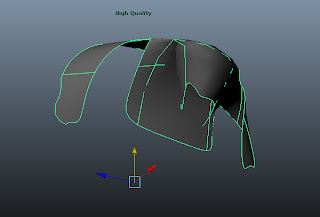For the matrix assignment, I worked using the side paneling surface of my car model, highlighted below:
Taking this piece into Maya, I explored a few different types of transformations; the transformations, however, are continuous from one type to the other, so the final form is completely different from where I started. Below are some images from the model scene:
Transformation order:
1) horizontal lengthening of the whole piece (x-axis left-right)
2) vertical manipulation along top edge
(y-axis up-down)
3) extrusion to augment the "bulge geometry"
(z-axis forward-backward)
4) folding the surface over itself
(lower points up, upper points down)
5) horizontal lengthening
The transformed pieces move in a snake pattern starting from the upper left, toward the lower right. The most interesting transformations for me were the extrusion and the final horizontal stretch after all other changes were applied. Once the bulge started to carve out a distinct region of space, I thought it would be interesting to fold the surface over itself; then I stretched it back out to clarify the spaces that were trapped in that fold. Here are a couple of snapshots of one of the pieces I found particularly interesting:
In this case, the two peaks that originally accommodated space for the tires of the car have become a part of this system, which most reminds me of two lateral wings intersected into a central planar surface; however, there is a tube of space that is trapped and hidden from view behind the planar surface which dominates the foreground here.





The transformations are interesting. The wheel wells create an interesting space.
ReplyDeleteNice job on making the car. You learned a lot. Maybe you can so me how you did that.
I like how the final form of the study appears to be a merger of three separate pieces that have been intersected. Which transformation produced this effect?
ReplyDelete